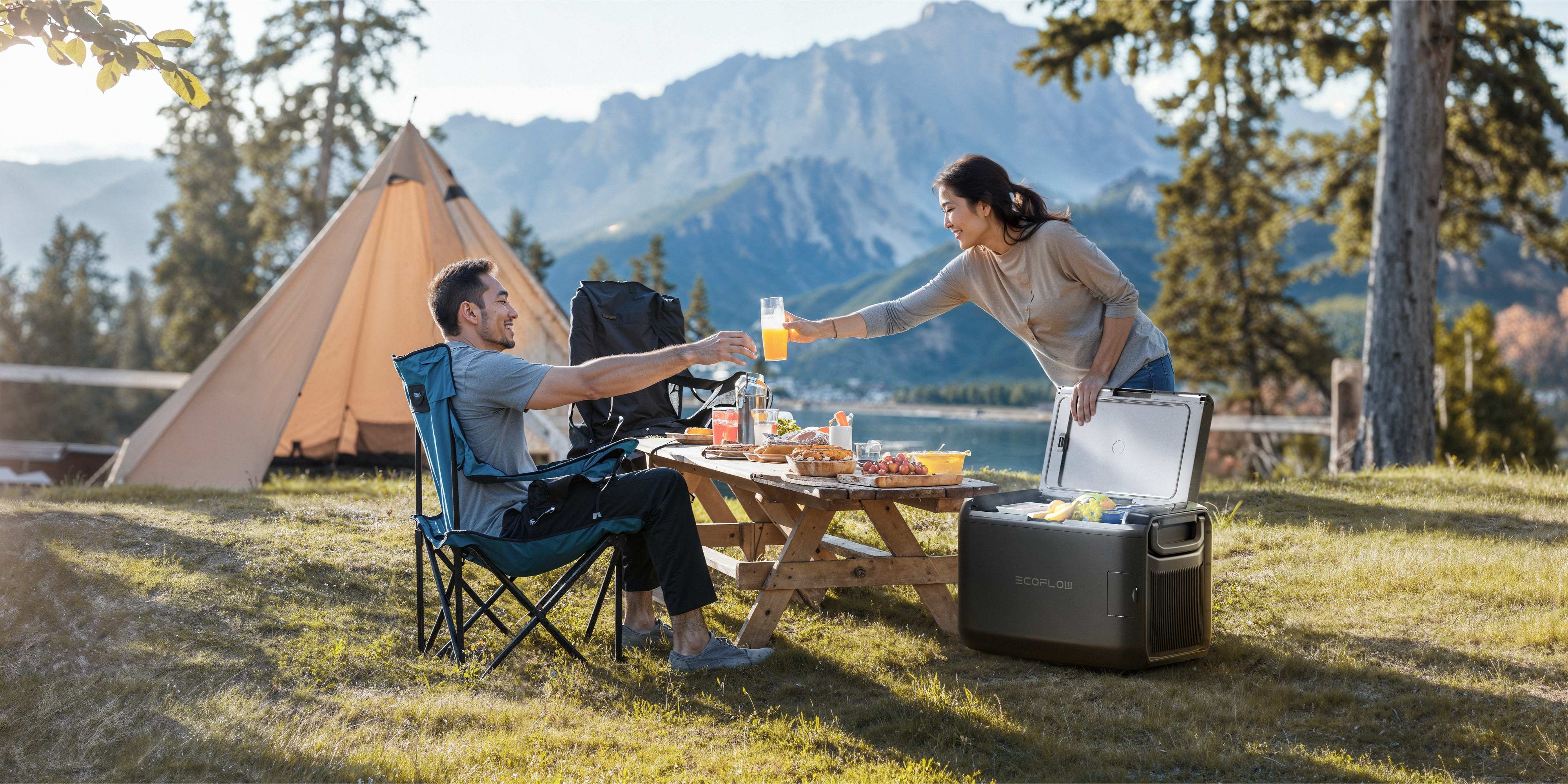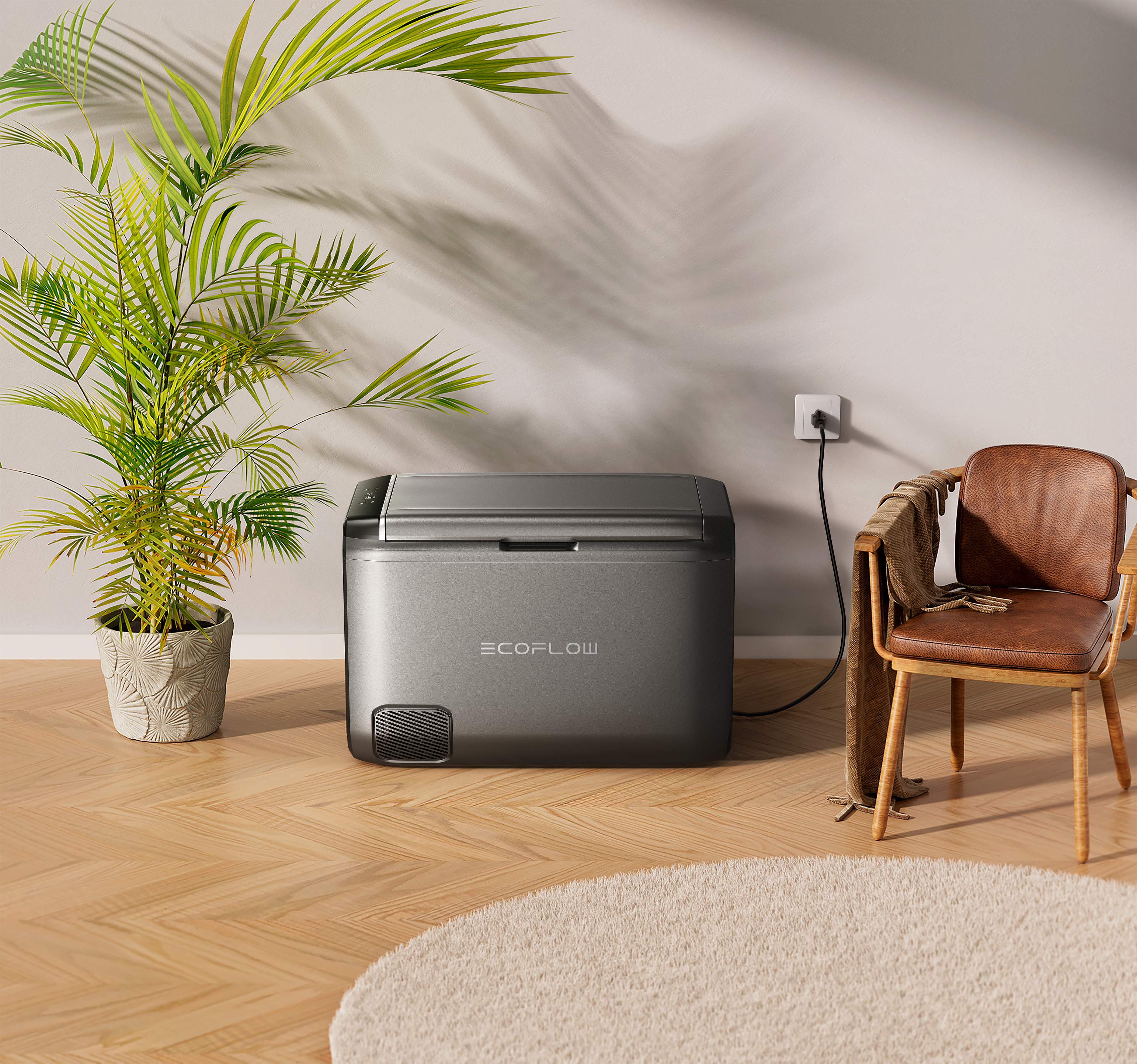Portable Fridge vs. Traditional Cooler: Which Is Better for Your Adventures?
- The Deep Chill: Cooling Performance & Duration
- Traditional Coolers: The Ice-Reliant Method
- Portable Fridges: Active, Consistent Cooling
- Pack it In: Real-World Capacity & Convenience
- Traditional Coolers: The Ice Tax
- Portable Fridges: 100% Usable Space
- The Bottom Line: Upfront Cost & Power Needs
- Traditional Coolers: Low Initial Cost, No Power Needed
- Portable Fridges: Higher Investment, Power Dependent
- The Right Tool for the Job: Which One Is for You?
- A Traditional Cooler Wins If:
- A Portable Fridge is Worth It If:
- The Modern Solution: The Best of All Worlds with EcoFlow GLACIER
- Final Thoughts
- Frequently Asked Questions
A portable fridge, also known as a portable fridge freezer, is an active cooling system. It uses a small compressor, just like your home refrigerator, to maintain a precise temperature. You simply set your desired temperature—for example, 38°F—and the fridge does the rest.
This means no ice is needed, ever. Your food stays perfectly dry and is kept at a consistent, safe temperature for the entire trip. Many models also have freezer capabilities, allowing you to bring along ice cream or keep your fresh catch frozen, something a traditional cooler can't do. It’s a true "set it and forget it" solution for food storage.
The Deep Chill: Cooling Performance & Duration
How well your food is preserved comes down to the cooling method. This is the most significant difference between a cooler and a portable fridge.
Traditional Coolers: The Ice-Reliant Method
A traditional cooler is a passive system. Its effectiveness depends entirely on the amount of ice you pack inside. High-end, roto-molded coolers can offer impressive ice retention, sometimes lasting 5 to 10 days under ideal conditions.
However, this method has a well-known downside: melting ice. As the days go on, you're left with a pool of frigid water at the bottom of the cooler. This can often result in soggy food packaging, waterlogged sandwiches, and a constant need to drain the meltwater. Your cooler's temperature is also inconsistent, being coldest right after you add fresh ice and gradually warming as it melts.


Portable Fridges: Active, Consistent Cooling
A portable fridge, also known as a portable fridge freezer, is an active cooling system. It uses a small compressor, just like your home refrigerator, to maintain a precise temperature. You simply set your desired temperature—for example, 38°F—and the fridge does the rest.
This means no ice is needed, ever. Your food stays perfectly dry and is kept at a consistent, safe temperature for the entire trip. Many models also have freezer capabilities, allowing you to bring along ice cream or keep your fresh catch frozen, something a traditional cooler can't do. It’s a true "set it and forget it" solution for food storage.
Pack it In: Real-World Capacity & Convenience
How much you can actually fit inside is another critical factor where these two options diverge significantly.
Traditional Coolers: The Ice Tax
A cooler's advertised capacity, measured in quarts or liters, can be misleading. A significant portion of that space—often 30% to 50%—must be dedicated to ice. A 50-quart cooler might only offer 25-35 quarts of actual space for food and drinks. While they are simple to use and incredibly durable (often doubling as a seat or a step stool), they require constant management, including sourcing and paying for ice and draining meltwater.


Portable Fridges: 100% Usable Space
With a portable fridge cooler, the entire internal volume is available for your provisions. A 45L portable fridge offers a full 45 liters of storage space. This means you can pack more food in a smaller overall unit, saving valuable space in your vehicle.
While portable fridges are heavier than empty coolers and have electronic components, their convenience is unmatched. There's no need to strategically stack items to avoid the water-log zone, and you never have to make a mid-trip ice run.
The Bottom Line: Upfront Cost & Power Needs
Your budget and access to power will play a huge role in your decision.
Traditional Coolers: Low Initial Cost, No Power Needed
A high-quality cooler is significantly cheaper upfront, with top-tier models ranging from $200 to $500. Their biggest advantage is that they require no power, making them a reliable choice for any situation, regardless of how remote. However, it's worth considering the recurring cost of ice, which can add up over years of use.
Portable Fridges: Higher Investment, Power Dependent
A portable fridge is a bigger initial investment, with prices typically starting around $500 and going well over $1,500. Their primary requirement is a stable power source. You'll need to connect it to your car's 12V outlet, a portable power station, or a solar panel setup. While the running cost is minimal (just electricity), the need for a power source is a crucial planning factor.
The Right Tool for the Job: Which One Is for You?
The best choice depends entirely on how you travel.
A Traditional Cooler Wins If:
- You primarily take short day trips, picnics, or backyard barbecues.
- Your budget is the main consideration.
- You are going somewhere completely off-grid with no access to a power source.
- You value rugged simplicity above all else.
A Portable Fridge is Worth It If:
- You enjoy long road trips, overlanding, or multi-day camping.
- You want the convenience of having both a fridge and a freezer.
- You need to store temperature-sensitive items like certain medications or baby food.
- You're tired of soggy food and the constant hassle of buying ice.
The Modern Solution: The Best of All Worlds with EcoFlow GLACIER
For those convinced that a portable fridge and freezer is the way to go, the next question is which one to choose. A standard portable fridge solves the ice problem, but the new EcoFlow GLACIER Classic redefines what's possible for off-grid convenience.
The GLACIER Classic is a complete, modern solution designed for every kind of outdoor adventurer. It directly addresses the final hurdle of portable fridges—power—by integrating a 298Wh battery directly into the unit. This provides up to 43 hours of wire-free cooling, giving you the freedom to set up camp anywhere without being tethered to your vehicle.
Understanding that one size doesn't fit all, the GLACIER Classic comes in three capacities (35L, 45L, and 55L) to perfectly match your vehicle and trip length. The larger 45L and 55L models feature dual-zone cooling, allowing you to use one side as a refrigerator and the other as a freezer simultaneously. Thanks to a highly efficient design and a 2-inch insulation layer, it offers maximum freshness with minimal power consumption.
And for those who want the absolute ultimate in outdoor luxury, the original EcoFlow GLACIER offers a groundbreaking feature: the industry's first integrated ice maker. Imagine having fresh ice for your drinks in just 12 minutes, miles from the nearest store. It’s the perfect flagship option for the adventurer who wants every possible convenience.
Final Thoughts
The debate between the portable fridge and the traditional cooler is a choice between simplicity and performance. The cooler remains a simple, affordable option for short, casual outings. However, for anyone serious about extending their adventures, a portable fridge is a game-changing investment.
By eliminating the need for ice, providing consistent and precise temperatures, and maximizing usable storage space, a portable fridge offers a level of convenience that allows you to travel further and stay out longer. With innovative solutions like the EcoFlow GLACIER series, you no longer have to choose between freedom and the comforts of home. You can have both.
Here are 5 FAQs to add to the blog post:
Frequently Asked Questions
Q1: Will a portable fridge drain my car battery?
This is a common concern, but most modern portable compressor fridges are designed with multi-level battery protection. These systems monitor your car battery’s voltage and will automatically shut off the fridge before the battery level drops too low to start your engine. For peace of mind on multi-day trips where you won't be driving, the best practice is to power your fridge with a dedicated portable power station. This ensures your vehicle's starting battery remains untouched while your food stays cold.
Q2: What are the different types of portable fridges?
While the blog focuses on the most popular type, there are two main kinds of electric coolers you should know about:
- Compressor Fridges: These use the same technology as your home refrigerator. They are extremely efficient, can maintain true freezing temperatures even in very hot weather, and are the standard for overlanding and serious camping.
- Thermoelectric Coolers: These use a solid-state heat pump. While they are lighter and less expensive, their cooling power is limited to about 30-40°F (18-22°C) below the outside air temperature, making them less effective in hot climates.
Q3: How should I pack a portable fridge for best results?
To maximize efficiency and extend your battery life, follow these simple steps:
- Pre-Cool Your Items: Always chill food and drinks in your home refrigerator before loading them into the portable fridge. This drastically reduces the initial power needed to cool everything down.
- Pack It Full: A full fridge stays cold better than an empty one. If you have extra space, fill it with bottles of water. They act as cold packs, helping to stabilize the internal temperature.
- Allow for Ventilation: Make sure the air vents on the outside of the fridge are not blocked. Proper airflow is essential for the compressor to work efficiently and prevent overheating.
Q4: Can I run a portable fridge entirely on solar power?
Yes, running a portable fridge on solar power is a fantastic way to stay off-grid indefinitely. The ideal setup involves connecting portable solar panels to a portable power station. The panels collect energy from the sun to recharge the power station during the day, while the power station runs your fridge around the clock. A setup with a 100W solar panel and a 500Wh or larger power station can typically power a fridge and other small electronics continuously.
Q5: How do I properly clean and store my cooler or portable fridge?
Proper care ensures longevity and prevents odors.
For a Traditional Cooler: After each use, wash the inside with mild dish soap and warm water. A sprinkle of baking soda can help with stubborn odors. Most importantly, ensure it is completely dry before closing it for storage. Storing it with the lid cracked open is the best way to prevent mildew.
For a Portable Fridge: Unplug and empty the unit. Wipe the interior with a soft cloth and a solution of water and baking soda. Dry it thoroughly and store it with the lid propped open to allow air to circulate.